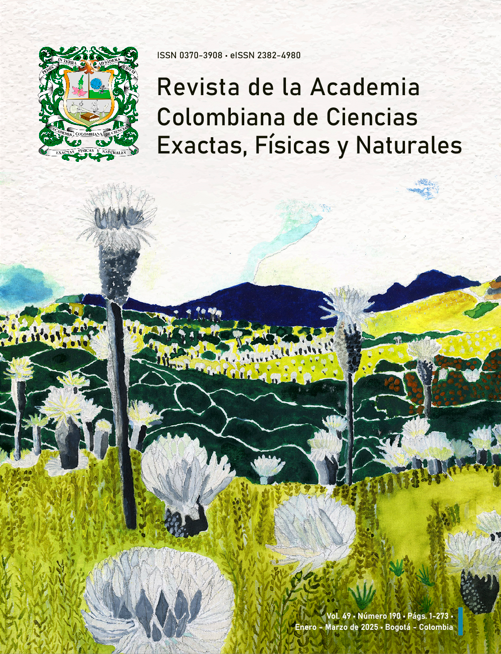Abstract
Kidney beans are a staple food due to their high protein, fiber, and mineral content. Colombia has 76,276 ha of crop and produced 104,919 t in 2024. In this study, we aimed to determine the effect of Aphelenchoides pseudobesseyi on the growth and production of kidney beans. Under semicontrolled conditions at the Montelindo Farm in Palestina, Caldas, two experiments were conducted in asbestos beds, where part of the kidney bean seedlings of the Citará and Quimbaya varieties were inoculated with 200 A. pseudobesseyi and other left uninoculated (control). The difference between the data obtained was evaluated using a t-test, with p<0.05. In both experiments, 8 and 18 days after the inoculation of A. pseudobesseyi in the bean seedlings, the nematodes caused light yellow lesions on 100% of the first pair of unifoliate leaves and angular necrotic lesions, respectively.At 20 days, in the Citará variety, 218 (Rf: 1.09) and 527 (Rf: 2.63) A. pseudobesseyi/plant were found in experiments I and II, respectively. In the Quimbaya variety, 234 (Rf: 1.17) and 290 (Rf:1.45) A. pseudobesseyi/plant were recorded in experiments I and II, respectively. The Citará variety infected with A. pseudobesseyi showed a significant reduction (p<0.05) in aerial dry weight and seed weight by 52.7% and 26.7%, respectively, in experiment I. In the Quimbaya variety infected with the nematode, there was a significant reduction (p<0.05) in seed dry weight by 34.6% in experiment I and in aerial dry weight by 26.2% in experiment II. This is the first report in Colombia of A. pseudobesseyi as a causative agent of leaf spots in kidney beans and reduced production.
References
Araya, C., & Hernández, J. (2003). Distribución agroecológica de enfermedades del frijol en Costa Rica. Manejo Integrado de Plagas y Agroecología, 68, 26-33.
Araya, C., & Hernández, J. (2006). Guía para la identificación de las enfermedades del frijol más comunes en Costa Rica. Ministerio de Agricultura y Ganadería. San José, Costa Rica.
Barrantes, W., Araya, C., Esquivel, A. (2006). Falsa mancha angular del frijol: una enfermedad que avanza en Costa Rica. Manejo Integrado de Plagas y Agroecología, 78, 91-93.
Chaves, N. & Araya, C. (2012). Pérdidas causadas por el amachamiento del frijol (Aphelenchoides besseyi Christie) y reacción del germoplasma comercial al patógeno. Agronomía Mesoamericana, 23, 1-12.
Chaves, N., Cervantes, E., Zabalgogeazcoa, I., Araya, C. M. (2013). Aphelenchoides besseyi Christie (Nematoda: Aphelenchoididae), agente causal del amachamiento del frijol común.Tropical Plant Pathology, 38 (3), 243-252.
Duncan, L.W., & Moens, M. (2006). Migratory endoparasitic nematodes. In R.N. Perry and M. Moens (Eds). Plant Nematology (pp. 124-152). CAB International.
Favoreto, L., Meyer, M. C., Calandrelli, A., da Silva, M.C., da Silva, S. A., Zambolini, A. C.(2021). Aphelenchoides besseyi parasitizing common bean in Brazil. Plant Disease, 105 (4), 748-751.
Federación Nacional de Cultivadores de Cereales, Leguminosas y Soya- Fenalce. (2025). Histórico de área, producción y rendimiento, cereales, leguminosas y soya. https://app.powerbi.com/view?r=eyJrIjoiM2FiYzM5ZTAtNjFmNi00MGQyLWFiYzYtNGI0YTJiZTcwZWQwIiwidCI6IjU2MmQ1YjJlLTBmMzEtNDdmOC1iZTk4LThmMjI4Nzc4MDBhOCJ9.
Fernández, F., Gepts, P., López, M. (1986). Etapas de desarrollo de la planta de fríjol común (Phaseolus vulgaris L.). Centro Internacional de Agricultura Tropical, CIAT, Cali, Colombia.
Fortuner, R., & Orton W. K. J. (1975). Review of the literature on Aphelenchoides besseyi Christie, 1942, the nematode causing “white tip’’ disease in rice. Helminthological Abstracts - Series B, 44, 1. 40p.
Franc, G.D., Beaupré, M. S., Gray, F. A., Hall, R.D. (1996). Nematode angular leaf spot of dry bean Wyoming. Plant Disease, 80, 476-477.
Guzmán-Piedrahita, O.A., Zamorano-Montañez, C., Aguilar-Marín, S.B., López-Nicora, H. (2024). First report of foliar nematode (Aphelenchoides pseudobesseyi) on soybean in Colombia. Plant Disease, 108, 535.
Jenkins, W.R. (1964). A rapid centrifugal flotation technique for separating nematodes from soil.Plant Disease Reporter, 48 (9), 692.
Meyer, M. C., Henning A. A., Almeida A. M. R., Godoy, C. V., Seixas, C. D. S., Yorinori, J. T., Ferreira, L. P., Soares, R. M., Dias, W. P. (2009). Manejo integrado de doenças da soja em regiões tropicais. In: 1° Simpósio Sobre Manejo de Pragas. Belém, PA. Anais. Belém:Embrapa Amazônia Oriental.
Meyer, M., Favoreto, L., Klepker, D., Marcelino-Guimarães, F. (2017). Soybean green stem and foliar retention syndrome caused by Aphelenchoides besseyi. Tropical Plant Pathology, 42, 403–409.
Sikora, R. A., Claudius-Cole, B., Sikora, E. J. (2018). Nematodes parasites of food legumes. Chapter 9. In: R. Sikora, D. Coyne, J. Hallmann & P. Timper (Eds.). Plant Parasitic Nematodes in Subtropical and Tropical Agriculture (pp. 290-345). CABI Publishing.
Salas, L. A., & Vargas, G. E. (1984). El nematodo foliar Aphelenchoides besseyi Christie (Nematoda: Aphelenchidae) como causante de la falsa mancha angular del fríjol en Costa Rica. Agronomía Costarricense, 8 (1), 65-68.
Salisbury, F. B., & Ross, C. W. (1994). Fisiología Vegetal. México, Grupo Editorial Iberoamericana.
Taiz, L., & Zeiger, E. (2006). Plant Physiology. 4ª ed. Sunderland (Massachussetts), Sinauer Associates, Inc., Publishers.
Tsay, T. T., Cheng, Y. H., Teng, Y. C., Lee, M. D., Wu, W. S., Lin, Y. Y. (1998). Bionomic and control of rice white tip disease nematode, Aphelenchoides besseyi. Plant Protection Bulletin Taipei, 40, 277-285.

This work is licensed under a Creative Commons Attribution-NonCommercial-NoDerivatives 4.0 International License.
Copyright (c) 2024 Revista de la Academia Colombiana de Ciencias Exactas, Físicas y Naturales


